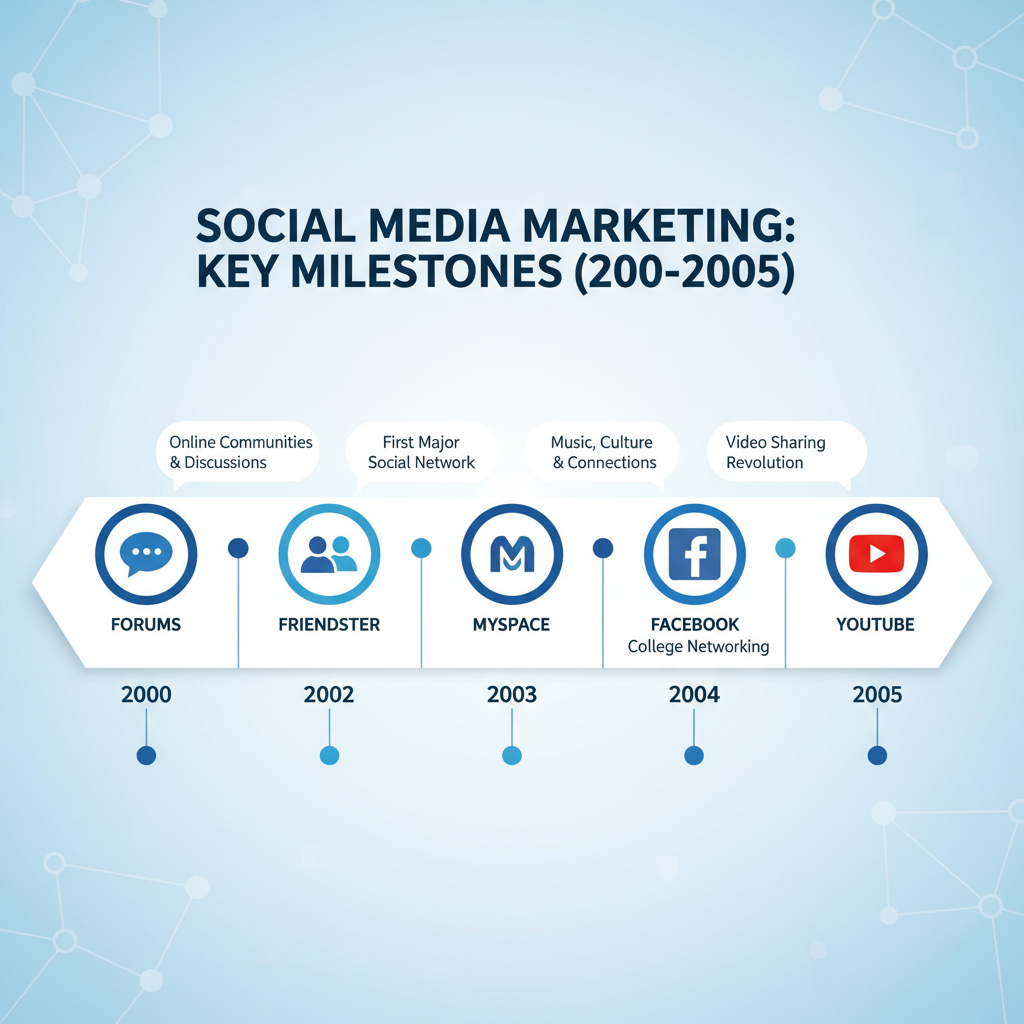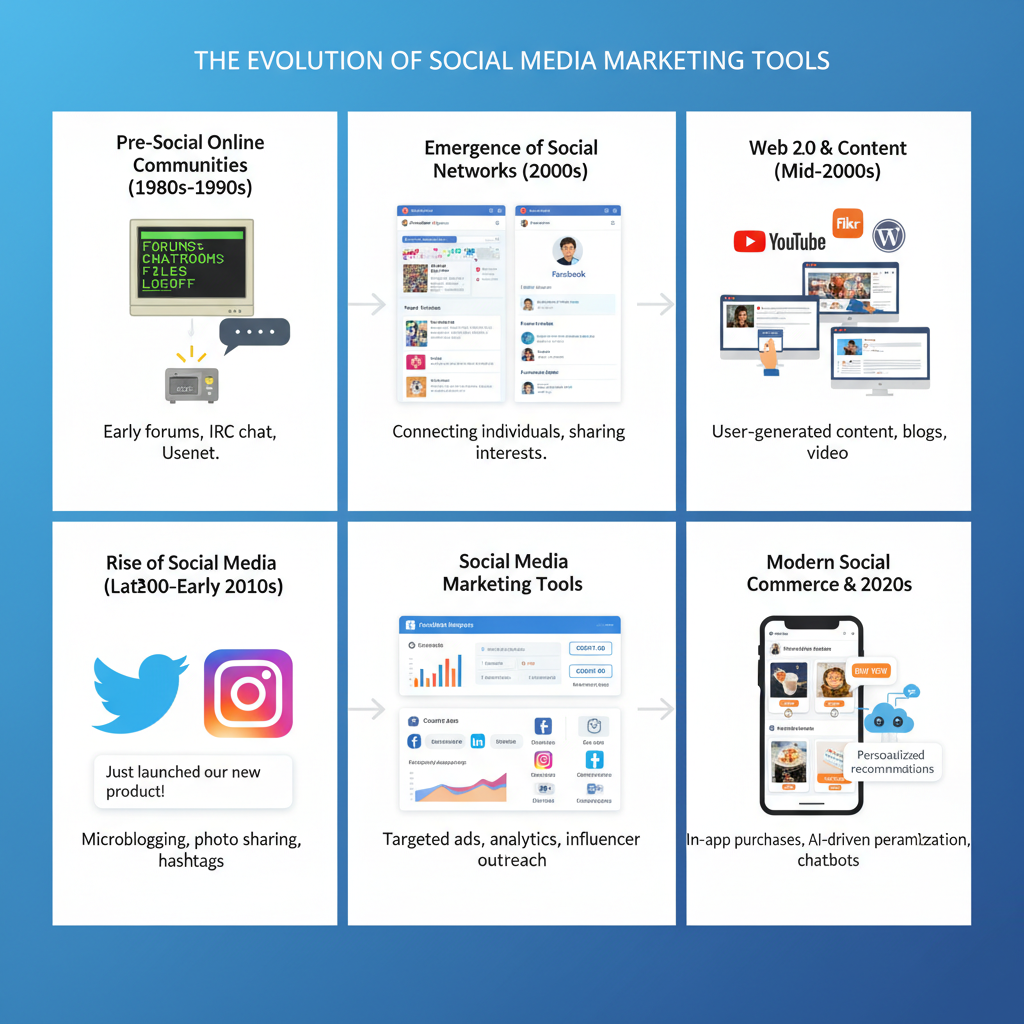Social Media Marketing History and Timeline Since 2000
Explore the history of social media marketing from early forums to major platforms, tracing key milestones and trends shaping its growth since 2000.

Introduction to the History of Social Media Marketing
Social media marketing has become one of the most powerful branches of digital marketing, enabling brands to connect with audiences in highly engaging and measurable ways. From its humble beginnings in online forums to today’s sophisticated, AI-driven campaigns on platforms like TikTok and Instagram, understanding when social media marketing started helps marketers appreciate its evolution and prepare for future trends. This timeline covers the milestones, technologies, and platforms that shaped the SMM landscape we know today.
---
What is Social Media Marketing?
Social media marketing (SMM) is the use of social platforms to promote products, services, or brands. It’s a subset of digital marketing focused on leveraging networks like Facebook, Instagram, LinkedIn, and Twitter to engage audiences, drive traffic, and generate leads or sales.
Unlike traditional marketing, SMM offers:
- Two-way communication between brands and consumers
- Highly targeted advertising using demographic and behavioral data
- Real-time performance tracking via analytics tools
Marketers today deploy a mix of organic content strategies, paid ad campaigns, influencer collaborations, and community engagement to achieve their goals.

If you’ve ever wondered "When did social media marketing start?", the answer lies in the early 2000s, though its roots can be traced back to pre-social-network communities.
---
Before Social Media: Forums, Bulletin Boards, and Early Communities
Before 2000, online marketing opportunities within communities were primitive by today’s standards but vital for setting the stage:
- Bulletin Board Systems (BBS) in the 1980s–90s allowed tech-savvy marketers to share updates with niche groups.
- Usenet groups and forums in the 1990s opened conversational spaces where brands could post product information or answer questions.
- Early community platforms like AOL chat rooms or Yahoo! Groups acted as proto-social media spaces.
While these channels lacked visual interfaces and algorithmic feeds, they proved that online networks could be powerful marketing spaces.
---
Friendster & MySpace: The First Global Platforms (2002–2003)
The early 2000s marked the true birth of social media marketing as we know it.
Friendster (2002)
Often overlooked, Friendster allowed brands to create profiles and engage with fans. Although its marketing tools were limited, it opened the door to using social graphs to connect with customers.
MySpace (2003)
MySpace took a more open approach:
- Offered HTML customization for profiles, enabling creative brand-focused pages
- Became a hub for music marketing—bands could directly promote songs to followers
- Enabled early influencer-style endorsements via popular user profiles

This period showed marketers the value of personalized brand spaces and community building.
---
Facebook (2004) and Unprecedented Marketing Reach
Launched in 2004, Facebook quickly expanded from a college network to a global platform by 2006.
Marketing potential highlights:
- Organic brand pages for updates, contests, and audience interaction
- Viral sharing of posts through friends’ feeds
- Targeting based on user data such as location, age, and interests
By 2007, Facebook introduced Facebook Ads, radically changing SMM with its high-precision targeting and sponsored posts.
---
YouTube & the Evolution of Video Marketing (2005)
Founded in 2005, YouTube revolutionized how brands used video:
- Enabled posting of ad slots alongside content
- Laid groundwork for brand-owned channels and video blogs (vlogs)
- Spurred concepts like unboxing videos, product reviews, and tutorials
Early adopters like Nike and Red Bull mastered storytelling through high-quality short films and viral video content.
---
Twitter’s Debut (2006) and Real-Time Marketing
Twitter’s microblogging style made it ideal for real-time marketing campaigns:
- Quick updates during live events (sports, award shows)
- Hashtag-driven campaigns for discoverability (#ShareACoke, #LikeAGirl)
- Rapid customer service responses via mentions and DMs
By 2010, Twitter Ads allowed promoted tweets, accounts, and trends, increasing visibility and engagement.
---
LinkedIn for B2B Marketing
Although launched in 2003, LinkedIn’s marketing potential grew substantially in the mid-2000s:
- Niche targeting of industry professionals
- Company pages showcasing services and job postings
- Sponsored posts and InMail ads for lead generation
LinkedIn cemented itself as the dominant platform for B2B conversations, particularly after the launch of LinkedIn Ads in 2005.
---
Instagram & the Rise of Visual and Influencer Marketing (2010)
Instagram’s launch in 2010 accelerated the move toward visual-first strategies:
- Brands showcased lifestyle imagery to inspire rather than just sell
- Birthplace of modern influencer marketing models
- Use of hashtags for storytelling and discoverability
By 2015, Instagram Ads became widely available, integrating seamlessly with Facebook's Ads Manager for cross-platform campaigns.
---
Advertising Platforms and Their Evolution
The growth of dedicated ad systems transformed SMM from a community activity into a measurable, ROI-driven discipline.
| Platform | Ad System Launch Year | Key Features |
|---|---|---|
| 2007 | Audience targeting, sponsored posts, News Feed ads | |
| 2010 | Promoted tweets, trending topics, account promotions | |
| 2015 | Photo/video ads, carousel ads, Stories ads | |
| 2005 | Sponsored InMail, job ads, audience segments |
This era marked the start of performance marketing, where ad spend could be tracked in real time.
---
The Mobile Era: Snapchat, TikTok, and Instant Engagement
With the shift toward mobile-first usage in the 2010s, new platforms emerged:
- Snapchat (2011) brought ephemeral content, direct messaging, and creative filters for branded experiences.
- TikTok (2016) disrupted video marketing with short-form, algorithm-driven discovery.
Mobile use meant campaigns had to be:
- Quick to grab attention
- Optimized for small screens
- Interactive and social-share ready
---
Milestones in Data-Driven Targeting and Analytics
Social media became more sophisticated with:
- Lookalike audiences for finding similar users based on existing customer data
- Conversion tracking pixels for measuring ad ROI
- AI-powered ad optimization for better targeting over time
These advancements allowed marketers to shift from mass broadcasting to tailored, hyper-relevant campaigns.
---
Current State of Social Media Marketing
Today, SMM is an integrated, multi-platform strategy:
- Organic engagement builds trust and brand visibility
- Paid media provides precision targeting
- Influencers act as authentic brand ambassadors
- AI-driven tools optimize scheduling, targeting, and content formats
Even small businesses can create global campaigns with the right tools and creativity.
---
Future Trends: Where Social Media Marketing is Heading
Looking ahead, expect:
- Augmented Reality (AR) ads integrated into shopping apps
- Voice and AI-powered commerce via social chatbots
- Deeper personalization through predictive analytics
- More regulatory focus on data privacy and transparency

As technology evolves, the line between social interaction and shopping will continue to blur. Understanding the history—from early bulletin boards to TikTok stars—gives marketers the context to innovate effectively.
---
Conclusion
So, when did social media marketing start? While its roots trace back to pre-2000 community spaces, the movement truly began between 2002–2004 with the rise of Friendster, MySpace, and Facebook. By following its journey, marketers today can appreciate the rapid evolution of tools and strategies—and position themselves to harness upcoming innovations in this dynamic field.
Ready to elevate your social media marketing? Whether you’re building brand awareness or driving sales, start by aligning your strategy with both the lessons from history and the trends shaping the future.



